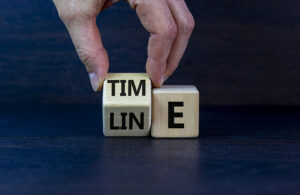Personal Injury Claim Process
The majority of personal injury cases settle long before going to trial. However, some cases may wind up going to court depending on the specific circumstances. Some cases may involve certain complexities that make it challenging to prove who was responsible for an accident and subsequent damages. In contrast, others may fail to reach an agreeable settlement between the claimant and the defendant.
To better understand what to expect with a personal injury case from a claim to the lawsuit, Below there are FOUR MAIN STEPS in the personal injury claim process with considerations based on specific circumstances throughout. Learn each step in your personal injury claim.
1. Consulting a Personal Injury Lawyer
After any accident and resulting injuries, first, seek medical care. Doing so will help begin the recovery process and generate medical records and bills that may help support a claim.

Once a victim has begun treatment, it’s best to consult with a personal injury lawyer. Most attorneys offer free consultations that give potential claimants the chance to discuss their cases and their options. The attorney will be able to help determine whether you have a valid claim and may choose to provide representation.
When consulting with an attorney, bring as much documentation as possible to help support your case. This documentation could include medical records, photographs of injuries and other damages, photos of the accident scene, and notes that you have taken about the accident and injuries. All of this evidence can help establish that you have a viable case.
You can also evaluate the attorney during your consultation to determine if they’re the right fit. A reasonable attorney will have plenty of experience in personal injury cases similar to yours, and they’ll be able to answer any questions you may have about your case.
The right attorney won’t over-promise during the consultation, either, as settlement amounts are often unclear at the start of a case. Additionally, you likely won’t need to pay an attorney until after the attorney settles, as personal injury lawyers charge clients on a contingency fee basis.
The defendant may also hire an attorney. Defendants in personal injury cases typically have around a month or longer to hire a lawyer before their initial court date.
2. Investigating the Case
If an attorney chooses to handle a case, they will begin investigating it. The attorney will work to understand how the plaintiff sustained their injuries and their extent, along with the costs and other damages involved in the case. The lawyer will contact the defendant’s insurer or attorney following this initial investigation.
While the attorney conducts the investigation, you will be able to focus on making a full recovery. Your attorney will handle all paperwork and provide details about the case to help you understand how the case progresses.
Potentially Settling Before a Lawsuit
Most personal injury cases settle before going to trial during the claims process. Your lawyer will begin to negotiate with insurance companies to discuss a potential settlement.
Negotiations typically begin when insurance companies make the first settlement offer. This offer may seem appealing, but it’s important to remember that insurers aren’t on the plaintiff’s side in these cases. Adjusters work to minimize the insurance company’s payout and will usually try to reach the lowest possible settlement amount. This is why having an attorney is critical.
Your attorney will be able to more accurately calculate how much your case is worth and determine whether the insurer’s offer is reasonable. Ultimately, you’ll have the final say regarding whether an offer is what you’re willing to accept.
3. The Pre-Trial Phases

The pre-trial process will begin if the case continues past the claims process. A few key phases will take place throughout this process, with specific deadlines in place for each. If a case reaches the pre-trial process, the time it takes to settle a case will likely see a significant increase. Cases that wind up going to trial can take as long as multiple years to settle, with the pre-trial process consuming much of that time.
The following are the main phases involved during the pre-trial process.
Filing a Complaint Against the Defendant
The first step of this process will be for the attorney to file a complaint in the appropriate civil court. This complaint will explain how the plaintiff was injured, the nature of injuries sustained, and how the defendant’s negligence contributed to the accident and injuries.
After filing the complaint, the plaintiff’s lawyer will have a limited time to find the defendant and indicate to them that they have a complaint against them. This will entail the attorney contacting the defendant in person to serve them the complaint, which prevents the defendant from being able to claim that they were unaware of the lawsuit. Typically, the defendant will have a limited time to respond to the complaint.
Discovery
This part of the pre-trial process entails both the plaintiff and defendant collecting evidence and documentation, along with certain other parties in the case. During the discovery phase, both sides can request nearly any material that may lead to the discovery of admissible evidence in court. Even if the material doesn't directly relate to the case, it could lead to other directly relevant evidence.
Specific types of discovery include:
- Requests for admissions - These requests involve asking another party to either admit or deny specific questions asked of them. For instance, a plaintiff may ask the defendant to admit to particular facts about an accident that could help prove the defendant’s negligence.
- Interrogatories - These are more open-ended than requests for admissions. Interrogatories may involve one party asking the other to indicate all of the evidence they intend to use to help support their arguments.
- Requests for production - Attorneys can also request all documentation and other evidence from the other party through requests for production. This discovery process step is often the most useful for attorneys, as it can provide them with all of the physical evidence they need to prepare for the trial process adequately. In some cases, parties involved in the case may also issue subpoenas to request evidence from non-parties.
- Depositions - This step involves requesting live testimony from witnesses and others involved in the case before going to court. The summoned witness or another party will need to testify under oath and submit to the recording of their testimony. Attorneys typically conduct depositions in their offices with representatives of the various parties involved.
Motions
Following or before the discovery phase, defendants may be able to file a motion with the court, which often entails defendants requesting that the courts dismiss claims or the case. In some instances, the court may hold a hearing to allow both the plaintiff and defendant to present their arguments before moving forward with a motion.
4. Going to Trial
In rare instances, personal injury cases may go to trial, which involves several steps. In civil trials, judges or juries will look closely at evidence to determine whether the defendant is liable for the plaintiff’s damages.
There are six main phases of the trial process, which are as follows:
Jury Selection
While some cases may only involve the plaintiff, defendant, and a judge, most will involve a jury and require the selection of a jury. During this process, the judge and the attorneys for the parties involved will ask potential jurors certain questions regarding the case. These questions can help determine whether a prospective juror’s life experiences or ideologies might affect their judgment and eliminate impartiality.
Opening Statements
After selecting a jury, the plaintiff and defendant’s attorneys will present opening statements to initiate communication during the trial process. At this point, witnesses don’t testify, and neither the plaintiff nor defendant will provide or use physical evidence.
Typically, the plaintiff’s attorney will first provide their opening statement to discuss the plaintiff’s injuries and other damages, which the defendant will need to prove they weren’t liable for in their defense. Defendants may even wait to provide their opening statement only after the plaintiff has concluded their main case.
Witness Testimony and Cross-Examination
Also known as the "case-in-chief" stage, this part of the trial involves each side presenting critical evidence and arguments to the jury. The plaintiff will attempt to use evidence to help prove that the defendant was liable for the plaintiff's injuries, pain and suffering, and other damages.
Throughout this stage, the plaintiff may incorporate expert and witness testimony to support their arguments and present medical records or other physical evidence. Having expert testimony is particularly invaluable in more complex cases, such as those involving medical malpractice or defective products.
Once the plaintiff concludes their case, the defendant will then have the chance to present their case. As the plaintiff, the defendant may choose to include witness and expert testimony to help prove that the plaintiff or another party was at fault for damages sustained. The defendant may also attempt to show that the plaintiff’s damages aren’t as severe as the plaintiff claims them to be.
After the defendant presents their case, the plaintiff may respond with a rebuttal. The plaintiff may only contest the defense's arguments and evidence but not present new arguments. In turn, the defendant may respond to the rebuttal.
Closing Arguments
At this point, plaintiffs and defendants will have the chance to make a closing argument and summarize their cases. This is the last time the plaintiff and defendant will be able to communicate their respective arguments to the jury before deliberation begins to take place.
During this process, the plaintiff will try to prove why the evidence supports their claims, while the defendant will attempt to show that the plaintiff has failed to prove that the defendant was at fault or to the extent the plaintiff claims.
Jury Instruction
The next step of the trial is jury instruction, when the judge determines which legal standards apply to the defendant's case and indicates them to the jury before deliberation. In many cases, the plaintiff and defendant will provide arguments and input to the judge. The judge will then explain certain concepts to the jury, including certain legal standards and the damages involved in the case, such as monetary and non-monetary damages.
Jury Deliberation and Verdict
Upon receiving instruction from the judge, the jury can then begin the deliberation process, which involves jurors attempting to agree on the defendant's liability. After the jury reaches a decision, the case will reach the verdict stage when the judge announces the verdict to the parties involved in the court.
Consult an Attorney to Discuss a Personal Injury Lawsuit
Even with a better idea of how a personal injury lawsuit works, you will benefit from working with a personal injury attorney to handle your case, particularly if it's complex and involves high costs and serious injuries.
